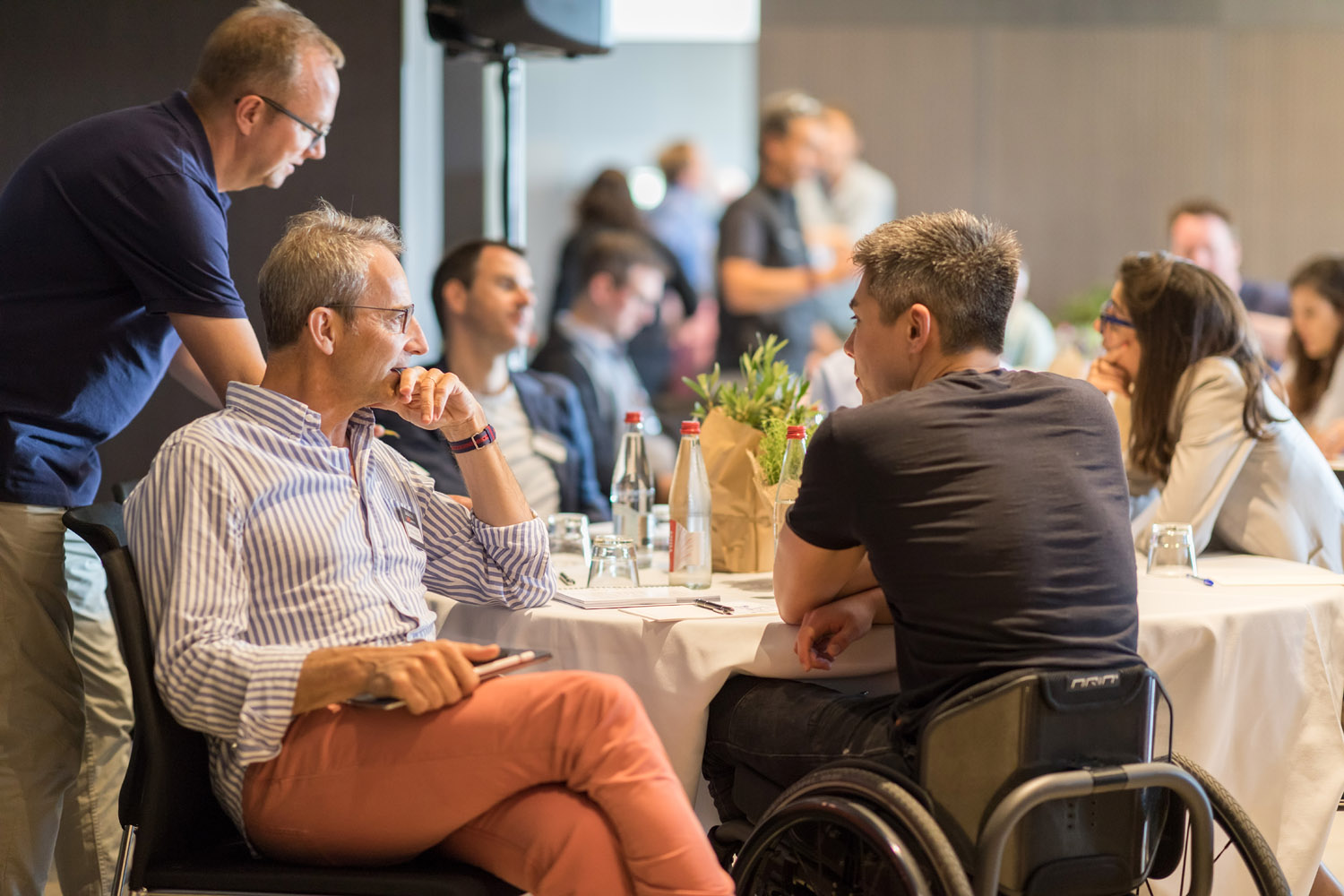Founder Interviews
Founded in 2011, the company has created a global bank debit network to rival credit and debit cards, and traditional payment methods such as cash and cheque.
The GoCardless platform is designed and optimised for taking invoice, subscription, membership and instalment payments.
GoCardless now [Autumn 2019] processes $13bn in transactions a year and counts brands like DocuSign, TripAdvisor and The Guardian among its 50,000 customers.
Nov 6, 2019:
'Fintechs TransferWise and GoCardless Partner to Let Businesses Collect Recurring Cross-Border Payments'
- Jeremy Kahn, Fortune
'Brunch interview with Hiroki Takeuchi, founder of GoCardless'
- Amy Lewin, Sifted.EU

Hiroki Takeuchi, Co-founder & CEO, GoCardless
When you started, GoCardless was addressing a different problem to the one you’ve ended up solving. Describe those early days and how you came to pivot the company?
I think of it as a journey of discovery in many ways. We [Takeuchi co-founded GoCardless with Matt Robinson and Tom Blomfield] were first-time founders, all in our early 20s, and we'd never set up businesses before.
Initially, we focused on helping informal groups collect money. Group payments were a problem we’d encountered before when I’d been part of student societies at university and Matt had been captain of his local football team, so we just saw it as an interesting thing to try and fix.
But frankly, we were more like a startup looking for a problem as opposed to the other way around.
We didn't know anything about payments at all at that stage. And it was through trying to learn about how payments worked, building a prototype and getting to know how people thought about payments that we realized a couple of things:
One was that the initial idea of fixing group payments was one of those things where it was a problem in theory, but it wasn't something that had anyone's hair on fire.
The second thing that we learned — and what led us to GoCardless — was that the way payments worked was broken. In particular, we saw that the way payments were happening online, which was predominantly using credit and debit cards, was fine for use cases like e-commerce and retail, which is where the majority of payments companies focus. But when it came to other types of payment, it wasn't a great fit.
In particular, we found that recurring payments, which is what we focus on today, was the area that was underserved by other solutions.
Frankly, at the start, we were more like a startup looking for a problem as opposed to the other way around.
If you cast your mind back to between Series A and Series B, what do you recall as your immediate priorities, after you’d closed your A round from Balderton? And how did that evolve as you went towards Series B?
I'd say that we were quite lucky in that we had tapped into this market where there was a huge amount of demand. And as a result, up until our Series A, we’d describe the way we grew as ‘growth by surprise’ because we were growing really fast, but we weren't doing any sales or marketing.
However, we had built some partnerships that were really effective and that was really the predominant way that we were growing.
Between Series A and Series B was when we really needed to start thinking about how to grow more proactively. It was fairly clear that we'd established product/market fit at Series A, but not necessarily that we'd established a clear growth engine. So that was the big focus for us at that time.
The reality is that this continues to be an on-going focus: how do you go from initially growing reactively, without any kind of sales and marketing, to put in place your first marketing and first sales efforts. And then how do you evolve those and upgrade them as you scale.

Hiroki Takeuchi talks to Bernard Liautaud at the Balderton CEO Collective 2018
Our focus after Series A was to build a clear growth engine
As you neared Series B (which you closed in January 2014) what were the metrics and KPIs you prioritised and why?
There's a general theme of becoming more sophisticated in the metrics that you track. In our Series A, it wasn't so much the metrics were fundamentally different, it was more about the early signs of promise.
Whereas in Series B, it was much more about the actual revenue growth and the way the business was scaling.
The other thing that was about demonstrating the viability of the model and how you get to profitability.
That's not to say that you're focused solely on profitability, but you do need to believe that at some level of scale, this is a model that's fundamentally going to be profitable. That was something that we were able to establish fairly early on, probably around Series B.
At Series B, it's more about the actual revenue growth and the way the business was scaling.
In terms of office space – as you’re scaling from Series A onwards, adding team-members all the while, when and how do you decide that it’s time to find new workspace? Is it simply a case of not being able to squeeze anyone else in so it’s time to move?
That's pretty much it. We've been through a bunch of offices. Our first office in Finsbury Square was still not really a proper office in the sense that it was one of those leases where they could kick us out any time. It was kind of like the office version of The Shining: the building was half empty, waiting to be knocked down.
We moved to our first proper office not long after Series B, because we couldn’t find a lease that would give us enough security. As the team grows larger, it becomes more unwieldy to move offices. If someone kicks you out with a couple of weeks notice when you're about 20 people that's not that big a deal. But when you're 70 or 80 people then that becomes trickier. So you need a bit more stability and a bit more room to grow into.
For a startup it’s always pretty much the same: you move into an office which is three times bigger than you think you're going to need for the next two years and then within six months you realise it’s not going to be big enough. Then within 12-18 months, you're busting at the seams, so you start looking for the next place.
As the team grows larger, it becomes more unwieldy to move offices.

Hiroki and Suranga Chandratillake at the Balderton CEO Collective 2018
When in the journey from A to B and beyond did you start to hire for executive roles?
The first leadership we hired into the business — I'm not sure I'd call them execs — was, after Series B and before the Series C.
We'd already hired some great product people, some great engineers, great designers and we were fairly confident in our ability to build product.
It was on the how-do-you-grow-proactively, how-to-scale-things side where we didn't really have much in the way of commercial experience. Initially, those hires were not so much around executive leadership, but about how do we actually build the first sales team? How do we build the first marketing team? It wasn't until after our Series C that we started hiring actual executives.
What's your advice for founders on when to make executive hires? For you it was a case of lacking sales and marketing expertise, but how do you know what you need to hire when in this particular phase of growth [i.e. A to B and beyond]?
I would say that what we undervalued at that stage was the need not just for domain expertise, but also scaling expertise. And it wasn't really until we started hiring people with that kind of expertise that we noticed a step change.
If I could go back again and rewrite the history of GoCardless, we probably would have hired some of that kind of experience earlier on into the journey. And in general, I’ve yet to go through a search where I feel like it was just the right moment to be hiring this or that person. By the time you've found that person, you're thinking you could have done with them a year ago.
By the time you've found the right executive with experience of scaling, you're thinking you could have done with them a year ago.
GoCardless is roughly 390 people worldwide today [autumn, 2019] – at what point did you feel it was the right moment to hire a Head of Talent / People to lead the search process? Was that quite late in the day for you?
It was fairly late on.
And we were a bit penny-wise pound-foolish in the sense that we were always very against hiring recruiters, and didn't really think it was worth spending money on.
But we underestimated the value of getting more people in faster.
We've now got quite a substantial recruitment and talent team, and that's made a massive difference in our ability to scale the team-up. But what’s also important is that it not only enables you to scale faster, but it also enables the people that you've hired to actually focus on doing their jobs. They still have to do a lot of interviews and they're heavily involved in the recruitment process, but you're taking some of that burden off the team themselves.
We underestimated the value of getting more people in faster.
When it comes to investors, you have an impressive roster of VCs – including Accel, Balderton, Google Ventures, Notion – so what’s your advice to founders on how to find the right investor match? What are the priorities when you make that decision on who to go with?
A lot of it is to do with the actual relationship between investors and the founders of the company and making sure that the investors that you're potentially getting on board are aligned with what you want to achieve. We’ve always valued that very highly.
One of the things I've always felt very fortunate about is that I have a set of investors that are very supportive. We're all aligned around a similar objective, which makes the whole thing a lot easier. You hear horror stories where you get investors that are not aligned and their interests are very different from what the company is trying to achieve. And that's where you start getting into problems.
The other place where you get problems is where you raise money from people that you fundamentally don't really have a shared set of values with or get on with.
At the end of the day, it's a very close relationship. In a way your investors are your boss, so making sure that they are people you want to work with is very important.
The relationship with an investor is very close, so make sure that they are people you want to work with.
You've built a global bank debit network, with offices in five countries today. Can you describe the internationalization process for GoCardless? Why did you decide to go into a particular country and how do you know when the moment's right to go there?
I'm not sure we've got that down to a science. We always believed very much in this being a global opportunity, and the vision has been there from very early on. So it's been more a question of when do we do it? The answer is always: as soon as you can.
The thing that really determines the timing is how repeatable and scalable the core business is. You don't want to have to spend time figuring out the building blocks of the business, and instead, you can focus on the building blocks of the new businesses outside of your home market.
We’d got the UK to a position where we felt we understood it well enough, and it was repeatable enough and scalable enough for us to then divert our attention to the new markets.
It was definitely something that we didn't get right on the first attempt. Initially, we were a bit too cautious. We just hired one or two people and we were spread too thin. We learned there's a minimum level of investment you need to make when you scale internationally to get things right. Opening international offices is a big endeavour and you need to be ready to make substantial investments and commit to the markets you go into.
The thing that really determines the timing of internationalisation is how repeatable and scalable the core business is
Do you believe in effectively replicating your HQ when you open international offices, and sending out key people from base? Or should each local office have its own regional identity built around local hires?
It's really important to build out a local presence with local hires — that makes a big difference. Otherwise, you are making it a lot harder for yourselves.
It's only as we started to really invest more into the local markets and open up local offices and hire people in those markets that we've really started to accelerate. However, I'm not sure there is a right answer to localization versus centralization; it's probably different in every business.
The important thing is probably just to be very clear about what are the things that you want to do locally and what are things you want to do centrally in support, and how do you structure that so that everyone knows where they stand.
One thing that typically startups seem to find difficult is retaining the distinctive culture that they had in the early days as they grow to hundreds of people around the world. What are the most important lessons you’ve learned in trying to cultivate a great culture at scale?
The way I think about it is that culture is the sum of everyone's behaviours. My view is you don't control the culture. The culture is an organic thing that evolves over time and you shouldn’t become too prescriptive about it or too fixated on a specific culture.
If you start saying 'This is our culture, everything has to conform to this and our culture has to be the same today now that we’re 200 or 1,000 people as it was when we were 20," it just doesn’t work because it all becomes a bit Big Brother-esque.
So I think of culture as something that’s underpinned by a set of foundational values. My belief is as long as you are very clear about what you value, and you have a culture that is true to those values, the culture will evolve or be different in the London office to how it is in the Paris or Melbourne offices.
Culture is something that’s underpinned by a set of foundational values. It's the sum of everyone's behaviours.
How do you instil those values in your later hires?
We’re very explicit about them.
We were always very clear about what our values are and in how we communicate them. But what's as important as communicating them is also adhering to them and living by them as a company. So the decisions that you make as a company, the decisions you make around who you hire, who you promote, who you exit – these all need to be very true to the values. And 80% of the time that’s quite easy. It's in the 20% of difficult cases that your values are truly embedded or not.
That might be when you’ve got that employee who's a superstar in terms of delivering on performance, but isn't really demonstrating the values. What do you do then? Obviously you have to give them a chance, you try and get them to change their behaviour to be true to those values. But if you can't, then that's the litmus test.
How important is the interview process for new hires in all this?
We have a very clear values-fit interview.
One of the things that we learned early on is that if you make the interview about culture-fit, then oftentimes that becomes 'Do I like this person or not?' And I don't think that's a very good test because if you just hire people that you like, you end up with this monoculture which I don't think is very healthy. You tend to end up with much less diverse teams, you're basically just hiring carbon copies of yourself and that can create some fairly bad dynamics.
Maybe in the early days, you can get away with it. But as you scale it’s not great. So we very explicitly moved away from culture-fit and more towards values-fit, because you can be more objective about values.
We very moved away from culture-fit to values-fit, because you can be more objective about values.
You mentioned diversity — how do you ensure you develop a diverse team from, early on, say Series A onwards?
The earlier you can embed diversity, the easier it is, because — guess what? — if you've got a team of 50 people and they're all men, you're going to struggle to hire women into that team.
Whereas hiring your first female hire into a team of five, that's a lot more achievable. So the earlier you can tackle that the better.
Sign up for our newsletter to stay up to date on news from Balderton, and our portfolio.